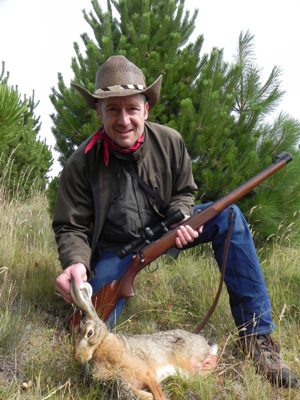Hunting Hares Without a Hound
By Gary Lewis

The pines were planted in rows and trimmed up to chest height. To see for any distance we had to bend at the waist or kneel and peer ahead. We were on the edge of a hay field, about a quarter of a mile from fields of alfalfa and oats.
Rabbit hunts are the same the world over. Just because we were in Chilean Patagonia didn't change the game.
At a rocky outcrop, from a tangle of downed logs, two hares leapt up and streaked away, with their black tails down, their ears laid back, they ran like deer, but zigged and zagged like low-flying doves through the timber.
My rifle was a bolt-action CZ, 22-caliber, with a European-style Mannlicher stock. I had a box of cartridges in one pocket and an 8-power monocular in the other.
These weren't the first hares we had seen. I had snapped a shot at a leggy lagomorph at 150 meters across the hayfield and missed as it ducked under the fence. Sam Pyke walked along with the camera since we only had the one rifle.
As big or bigger than our own black-tailed jackrabbit, these hares were no easier to hunt. If anything, they were faster. Or my reaction time had dulled since I hunted jackrabbits in the Christmas trees back home in Oregon City.

Three nights before, Coyhaique River Lodge had served carpaccio made from the loin of the liebre, pronounced lee-vre. When they told me what it was, I thought I heard the word liver. Too bad they wasted it on me when they could have fed it to the dogs, I thought. But upon further inquiry, I realized that it was liebre, the red hare. Bueno.
Carpaccio can be made from the thin-sliced loin of various wild game. Marinate it in lemon and lime then serve with capers, olive oil, chilis and parmesan.
They had shared a rabbit with me. I wondered if I would be able to return the favor.
Populations of rabbits and hares go up and down in cycles based on the predator base and food supply. Here at home, hunters can find high numbers of rabbits in some parts of western, central and eastern Oregon. When the numbers get out of control, the beasts can wipe out a harvest of alfalfa and other crops.
It didn't take a crystal ball to see that is what was happening on that estancia in Chile. We were there to fish, but coming back from the river, I counted 24 rabbits in a two-mile stretch. With an hour to hunt before I packed for home, I found a rifle to borrow.
We circled at the base of a canyon and bounced a half a dozen rabbits from the brush. With the bolt-action rimfire, my best chances were limited to standing shots. Finally one hare stood and I missed him.
Another one tore out from the arroyo below us and legged it up the other side. When he was level with us across the canyon, he turned right and that's when I connected.
Back at the lodge, the hare yielded the meat from its hams and two ten-inch strips of loin, about as big around as a half-dollar.
Wherever the hunt takes you in North America, South America, Africa, Europe or New Zealand, you can find rabbits or hares. But you don't need to go far from home to score the main ingredients for a rabbit dinner.
According to my sources, rabbit numbers are low in and around Christmas Valley and Fort Rock. When I talked to Nikki Aamodt of Diamond A Guides in Burns, she pointed south and east toward Crane, Frenchglen and Fields, where a hunter is likely to find more bunnies.
The classic way to pursue hare and rabbit is with a pack of beagles, but a hunter without a hound can do as well.
One of the most productive methods is the drive. Groups of three to five work the best. Walk in a line through good rabbit habitat, spread out with about ten yards in between. Rabbits will be pushed out ahead of the group or hold tight to run the opposite direction after the drive has moved past.
For safety's sake, high-visibility blaze orange is essential and the group leader should ensure the line stays intact.
When flushed, jackrabbits zig and zag, putting brush and distance between the hunter and hunted at speeds up to 35 miles per hour. Unlike cottontails, jackrabbits don't often circle back, they're headed for the horizon. Be ready, you'll probably not get a second chance.


